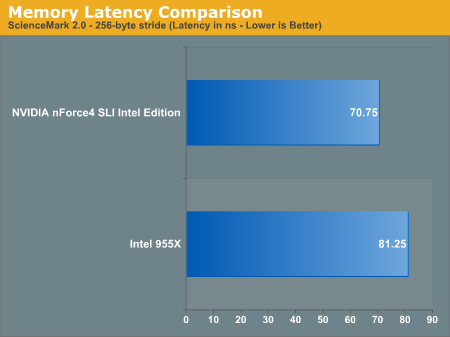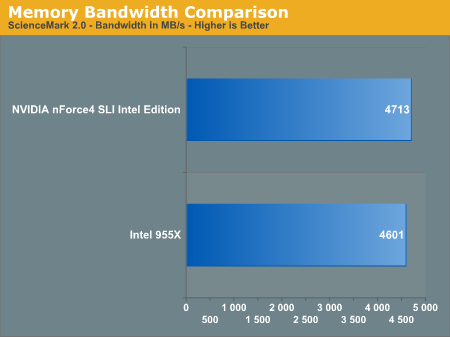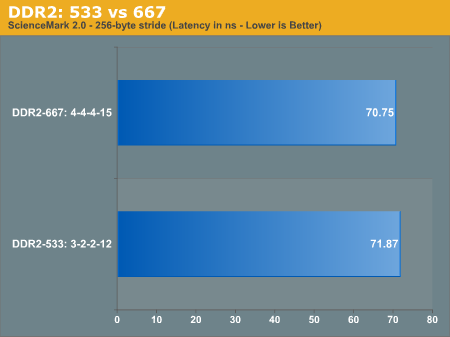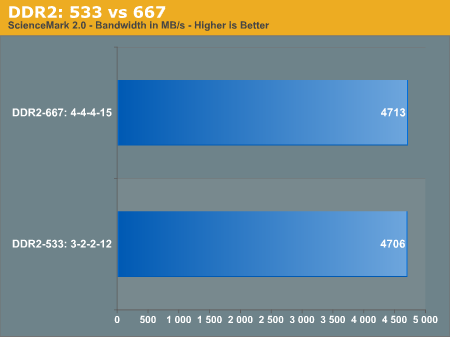Dual Core Intel Platform Shootout - NVIDIA nForce4 vs. Intel 955X
by Anand Lal Shimpi on April 14, 2005 1:01 PM EST- Posted in
- CPUs
Memory Performance
The biggest question on our minds when comparing these two heavyweights was: who has the better memory controller? We turned to the final version of ScienceMark 2.0 for the answer.

Amazingly enough, at the same memory timings, NVIDIA drops memory latency by around 13%. This is a worst case scenario for memory latency. In all of our other memory tests, the nForce4's memory controller was equal to Intel's controller - but even any advantage here is impressive, not to mention such a large advantage.

NVIDIA's latency reduction and DASP algorithms offer a negligible 2% increase in overall memory bandwidth. While you'd be hard pressed to find any noticeable examples of these performance improvements, the important thing here is that NVIDIA's memory controller appears to be just as good as, if not faster, than Intel's best. Kudos to NVIDIA - they have at least started off on the right foot with performance.
DDR2-667 or 533?
When Intel sent us their 955X platform, they configured it with DDR2-667 memory running at 5-5-5-15 timings. NVIDIA sent their nForce4 SLI Intel Edition board paired with some Corsair DIMMs running at 4-4-4-15 timings at DDR2-667. Given that we have lower latency DDR2-533 memory, we decided to find out if there was any real performance difference between DDR2-667 at relatively high timings and DDR2-533 at more aggressive timings. Once again, ScienceMark 2.0 is our tool of choice:

Here, we see that even at 3-2-2-12, DDR2-533 isn't actually any faster than DDR2-667.

...and it offers slightly less memory bandwidth.
It looks like there's not much point in worrying about low latency DDR2-533, as higher latency DDR2-667 seems to work just as well (if not a little better) on the newest Intel platforms.










96 Comments
View All Comments
Spajky - Saturday, May 7, 2005 - link
Some comments:Memory Performance:http://www.anandtech.com/cpuchipsets/showdoc.aspx?...
Here should be included also WinRAR´s built_in benchmark & hardware test" in KB/s,
since it can be treated as a real life memory subsystem benchmark (& NOT a Data
Compression Bench! for CPU for example)
WinRAR´s built_in benchmark & hardware test" :
some tests/benchmarks & explanation HOW IT WORKS, here:
http://freeweb.siol.net/jerman55/HP/benchMem.htm
Pontius - Tuesday, April 19, 2005 - link
Didn't realize there was no hardware XOR. Thanks for clearing that up elecrzy.xsilver, RAID 5 is a big deal and is a long way ahead of RAIDs 0 and 1. Most motherboards offer RAIDs 0 and 1, but only high end expensive ones offer onboard RAID 5. Without it, you need a SCSI or SATA RAID card which will run you a couple hundred bucks. To have that on a desktop board is a major deal. But again, since it's done by the CPU without XOR hardware, it's not that big a deal I guess.
elecrzy - Monday, April 18, 2005 - link
sorry i meant #88elecrzy - Monday, April 18, 2005 - link
#89: the chipset doesn't offer its own XOR processor for RAID 5 so it has to rely on the cpu to do the calcs. this basically means you lose alot of performance(high cpu usage) when compared to hardware raid cards.mickyb - Monday, April 18, 2005 - link
RAID 5 and 10 is indeed a big deal for a built in chipset. It is a little outside the scope for a desktop, but cool none the less. I would have to also give a win to nVidia for providing GbE on the chip. I guess Intel would rather people use their GbE separate chip.Zebo - Sunday, April 17, 2005 - link
Zebo - Sunday, April 17, 2005 - link
Intel has a nice chipset, as usual. Nvidia, as usual, clueless about audio desires which would add insignifigant price to chipset at great gains to most consumers. I don't really see the Nvidia recomendation at all unless you NEED, Sli. Intel has more feature, way better audio, the NCQ differences are really none and it's cheaper.xsilver - Sunday, April 17, 2005 - link
#88 -- I think it is old news... I think the older 9xx chipsets offered raid 0,1 for free so offering raid 5 on the newer chip may not be so crash hot??and questar, talking to you is a bit like talking to a brick wall....
a lot of us here already explained that we are arguing about performance NOT volume... what you specify as "qualifications" is due to the sheer volume intel ships.... most people are aware that AMD only has 15% of the market.
If IBM,HP,Dell dont want to "qualify" AMD systems, its their loss, not ours
but no matter how you argue it, AMD has the performance advantage on everything, high end, middle and low end right now and only the laptop pentium M is the performance advantage for intel right now
Pontius - Sunday, April 17, 2005 - link
Am I the only one that noticed that the Intel chipset supports on board RAID 5?!?! That's amazing! No need to buy expensive raid cards anymore. I'm surprised they didn't pay any attention to that in the article.stevty2889 - Saturday, April 16, 2005 - link
My case meets the standards for running prescotts..my 3.2 ES and my 2.8@3.5ghz ran perfectly fine in the same case, the 3.2ES also on the same motherboard, with all the same components, and neither my 2.8 or 3.2ES had the heat issues of my 3.4ghz chip. Not all of them run too hot, but some seem to do so no matter what cooling you throw at them. The 3.4 is still running warmer with water cooling, than my 3.2 ES(which I got from the chip loaner program) is with air.